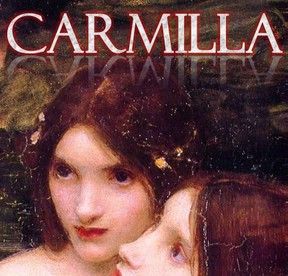 On the surface, it should look like Joseph Sheridan Le Fanu's novella would wipe the boards.
On the surface, it should look like Joseph Sheridan Le Fanu's novella would wipe the boards.
When he wrote Carmilla, he was tapping into a very rich tradition of female vampires. The earliest vampiric figures of all had been women.
Historically, cases like that of Arnold Paole and Peter Plogojowitz might have been the most famous, but they were surrounded by many more which involved the feminine undead.
When Coleridge had written his vampire into poetry, he'd made her female, despite his inspiration being male.
It was Byron and John Polidori who had broken from tradition by making their vampires male. All those 19th century authors following suit were pretty much reinventing Lord Ruthven over and over again. Le Fanu had disregarded what looked like a modern fad, mere decades old, to dive into a zeitgeist which had survived centuries. The human psyche, it seemed, wanted monstrous women with fangs, not men.
When Sheridan Le Fanu published Carmilla, it was extremely well received. It was quickly republished too, in a second collection, such was the appetite for reading it. Bram Stoker was certainly inspired by the storyline. He stole a couple of key devices for Dracula.
However three factors played firmly into Stoker's hands. They would combine to diminish Carmilla and raise Dracula into archetypal status.
- The long-running penny dreadful serial Varney the Vampire had fixed the idea into the public conscientiousness of vampires also being male. This allowed male vampires to evenly compete with female ones.
- Dracula physically entered Britain. Laura might have been an English woman, but she stayed firmly in Austria. Stoker's genius was to bring the horror home.
- Movies. The first movie ever projected for an audience happened in 1895. Bram Stoker published Dracula in 1897. The popularity of his book rose alongside the birth of the silver screen. The first film based on the novel happened in 1922, when Nosferatu brought vampires into theaters. Count Dracula has since held a significant role in 217 movies.
Carmilla was not only written twenty-five years too early for the movies, but it contained themes which movie-makers have disdained. Foremost amongst these is the notion of lesbianism. Most references to her ignore that aspect entirely. If Carmilla does appear, then she's heterosexual.
Only one director has attempted to properly adapt Le Fanu's story. In 1960, Roger Vadim gave us Et Mourir de Plaisir (And to Die of Pleasure). The French movie was translated and released in English as Blood and Roses, but it was ten minutes shorter. The US edit had carefully cut out any reference to Carmilla's lesbianism. Laura was merely a gullible friend and victim.
It's only when you get to the 2009 movie Lesbian Vampire Killers that Carmilla is allowed to be gay. Even then, the story isn't that laid out by Le Fanu. Laura has been air-brushed from the picture and the whole thing is played for laughs. She's not Carmilla. She just bears her name.
In short, it would seem that popular culture still isn't ready for Carmilla and Laura. The world would much prefer Edward and Bella.






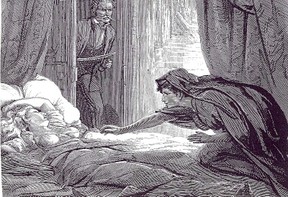 Joseph Sheridan Le Fanu definitely took his cue from
Joseph Sheridan Le Fanu definitely took his cue from 


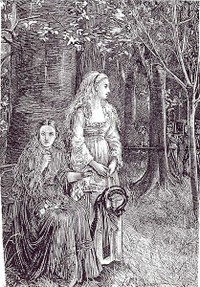 Many readers make the mistake, based on Carmilla's much vaunted reputation, that there will be scenes in this story describing explicit lesbian activity. There is not.
Many readers make the mistake, based on Carmilla's much vaunted reputation, that there will be scenes in this story describing explicit lesbian activity. There is not.

 On the surface, it should look like Joseph Sheridan Le Fanu's novella would wipe the boards.
On the surface, it should look like Joseph Sheridan Le Fanu's novella would wipe the boards. 

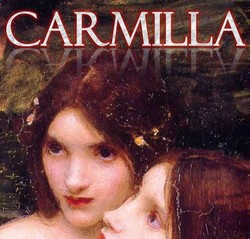

 St Tydecho's Churches in West Waleson 09/03/2014
St Tydecho's Churches in West Waleson 09/03/2014
 Goodies for an Outlander Premiere Partyon 03/06/2015
Goodies for an Outlander Premiere Partyon 03/06/2015
 Holocaust Memorial Day Interview with Rainer Höss, Grandson of Rudolf Architect of Auschwitzon 01/24/2015
Holocaust Memorial Day Interview with Rainer Höss, Grandson of Rudolf Architect of Auschwitzon 01/24/2015
 Romantic Valentine Gifts for an Outlander Fanon 01/16/2015
Romantic Valentine Gifts for an Outlander Fanon 01/16/2015

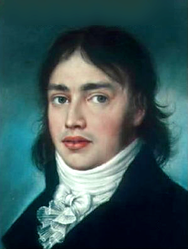

Comments
You must have posted that as I responded! Yes, she does. It apes how they've been culturally perceived quite well. Which is a great shame.
Also fitting how Carmilla essentially worships Dracula in the game.
Yes, she will be, though Carmilla there has little else in common with Carmilla in the story. The gaming one is subservient to Dracula, worshiping him like a God. It's really weird to see how that worked out.
Is this the Carmilla from Castlevania: Circle of the Moon?